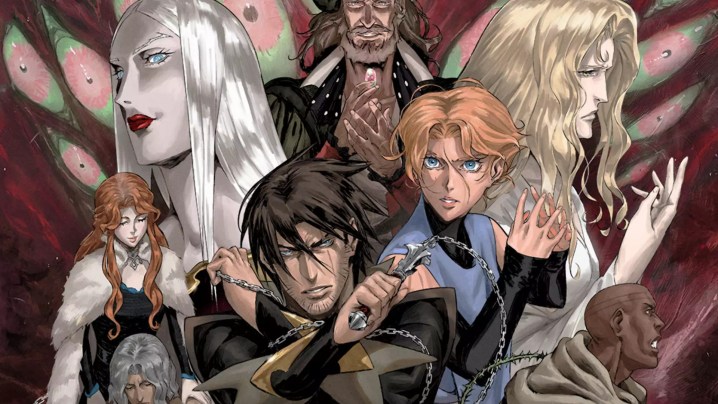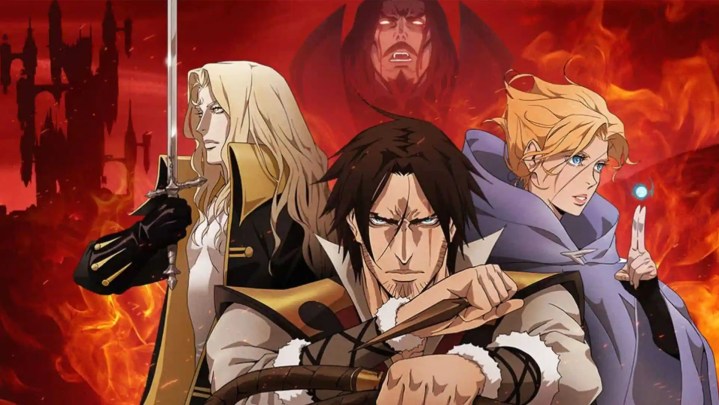While the infamous “video game curse” is still prevalent today in modern-day adaptations, Netflix’s Castlevania animated series was arguably the first to break that pattern. It originally premiered in 2017 with a brief, four-episode-long first season, but the impact that it had seemed to finally tap into the potential of video game series adapted for TV and/or film.
The jury is still out on whether live-action productions could do justice to their source material — though, perhaps HBO’s The Last of Us could produce that first major shift — but the animation medium looks to have unlocked something. With fantasy cemented as a pop culture staple thanks to the likes of House of the Dragon and The Lord of the Rings: The Rings of Power, Castlevania is an excellent animated dark-fantasy series to binge. From its stylish anime inspiration to its stunningly animated set pieces, it chases that genre high.
The perfect blend of Western style with Japanese anime

As a whole, the animation format is still criminally underrated despite the incredible depth of possibilities it offers, but it’s still made impressive strides over the last decade or so. That includes the Japanese anime genre, which has effectively gone from a niche form of entertainment spoken about in hushed tones to a viable global juggernaut.
And while Castlevania itself isn’t an anime in the strictest sense of the word — as much as Netflix loves to capitalize on the word for marketing purposes — it certainly takes all of the best stylistic flair from the genre as an influence. There’s not a single character design in the show that doesn’t drip with a gothic style that brings the best of both worlds when it comes to western animation and Japanese anime — courtesy of Austin-based studio Powerhouse Animation.
On top of Powerhouse Animation Studios’ fantastic character designs, the team’s overall art direction for the show and the animation itself is a sight to behold the longer that Castlevania goes on. By the final season, nearly every frame is a showstopper, and the action set pieces are nothing short of visual spectacles.
Everything depicted on the screen looks meticulously crafted, with every fight sequence pushing the capabilities of animation to the absolute limit. That’s not to say that Castlevania is lacking in the narrative department, but prospective fans coming from a live-action show to animation certainly won’t go wanting for visual eye candy.
An immersive dark fantasy world and unique cast

The fantasy genre generally lives or dies based on how compelling its world is, and Castlevania depicts one that’s more than worth getting invested in. Between the aforementioned cocktail of gothic and anime-inspired art direction, the series establishes an interesting universe ripe with a gloomy atmosphere.
While they’re not the grounded, live-action locales seen in the likes of HBO’s fantasy shows, fans of dark fantasy overall should feel right at home with Castlevania‘s style and brooding nature. A fantasy world, however, is only as good as the characters who populate them. Thankfully, this series has a wide cast of characters with unique personalities — it not diificult to get attached to Trevor Belmont, Sypha Belnades, and Alucard’s heroics.
With Trevor taking on the role of the delinquent with a heart of gold, Sypha serving as the determined and righteous heroine holding the team together, and Alucard playing the brooding and prophetic hero seeking purpose, Castlevania creates an emotionally investing trio with distinct motivations that make them intriguing.
The show does an equally great job both creating fascinating villains and antiheroes as well, from the heartbroken and vengeful Dracula to his emotionally traumatized underlings Hector and Isaac. By season 3, Castlevania even takes some cues from Game of Thrones in terms of narrative structure, as both returning and new cast members embark on branching storylines to sow the tantalizing seeds for the climactic fourth and final season.
A loving homage to its video game roots

Part of the reason so many live-action video game adaptations — and the same could be said for anime adaptations — fall flat on their faces critically is what can only be described as the studio feeling embarrassed to acknowledge that the source materials are, in fact, video games.
Seeing these beloved franchises making money in that medium seems to be the sole motivating force behind adapting them elsewhere, but Castlevania looks like a labor of love and reverence for gaming from top to bottom.
As far as Castlevania specifically goes, the series strikes a perfect balance between paying homage to its gaming roots while tastefully making creative changes to better suit a serialized story for TV.
Even the choreography for the fight scenes and the immaculate animation that brings them to life look like a vibrant video game boss fight scripted for this medium. Not to mention the ghoulish creatures of the night, the weapons, and the magic on display, all of which are complemented by the RPG-like party motif that Trevor, Sypha, and Alucard embody.
The critical success that Castlevania has earned hasn’t gone unnoticed — it even escaped Netflix’s cancellation trigger finger — with a sequel series subtitled Nocturne currently in development. But if this series has still gone under the radar for some for one reason or another amid this fantasy genre renaissance, Castlevania‘s sense of visual style, characterizations, and embracing of its roots make it a captivating watch even for those uninitiated in the Konami video game franchise.
All four seasons of Castlevania are available to stream now on Netflix, with the Nocturne sequel series currently in development for the streamer.



